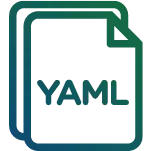
YAML Translation Services
A data serialization format that is both flexible and human-readable, YAML is widely used for structuring data hierarchically, in addition to data exchanges and settings. The experienced language service providers at Trusted Translations appreciate the simplicity of its syntax and solid support for complex data structures, particularly when exchanging data between systems. Today, it’s a popular choice for a broad range of data processing, automation, and software development applications.

YAML Translation Services
A data serialization format that is both flexible and human-readable, YAML is widely used for structuring data hierarchically, in addition to data exchanges and settings. The experienced language service providers at Trusted Translations appreciate the simplicity of its syntax and solid support for complex data structures, particularly when exchanging data between systems. Today, it’s a popular choice for a broad range of data processing, automation, and software development applications.
File Formats Related Content
Home » Services » File Formats » YAML
Why translate YAML Files?
YAML files frequently store language-specific strings. Once translated, these strings enhance user experiences by ensuring that consistent settings and content are accessible to global audiences. Other UI elements (like error messages, meta descriptions, prompts, menus, labels, and instructions) are translated into the user-selected display language.
Launched in 2001 as Yet Another Markup Language, YAML retained the acronym, but was quickly renamed as YAML Ain’t Markup Language, underscoring its data-oriented purpose. Although targeting many of the same applications as XML, YAML’s lean syntax uses Python-type Indentations for nesting, with no quotes needed for most string values.
While tabbed or spaced indentations indicate their data structure and hierarchy, YAML files represent data in key-value pairs. Much like bullets, lists are indicated by hyphens before each item, while the hash symbol is used for notes.
In some apps and content management systems, content, metadata, and structures are often defined in YAML files. When their UI strings and settings are stored in strings expertly translated by well-qualified professionals (like the Trusted Translations localization teams), they allow more effective management of multilingual content. This ensures that each version is configured properly and functions smoothly, with user-friendly displays that reach out to global audiences.
Benefits of Translating YAML Files
A user-friendly configuration management tool in development environments pursuing internationalization, translated YAML streamlines collaborative efforts for multilingual teams, with settings and configuration instructions remaining consistent across multiple languages. This also helps avoid legal issues, by ensuring compliance with local regulations.
By supporting multiple languages, YAML files offer user-friendly gateways to international audiences, particularly in countries where the original language of a website or app is not widely spoken. By localizing YAML files, the Trusted Translations staff of native linguists helps consumers to interact more comfortably with foreign apps and websites. The outcome: content presented in their native languages drives closer engagement and higher conversion and satisfaction rates.






































